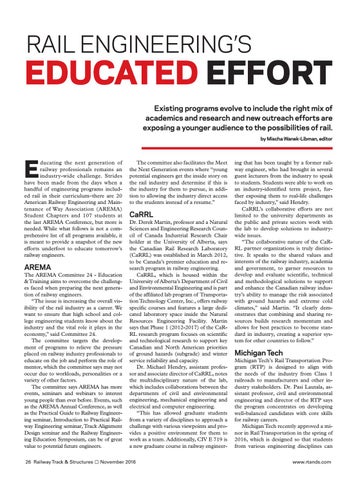rail engineering’s
educated effort Existing programs evolve to include the right mix of academics and research and new outreach efforts are exposing a younger audience to the possibilities of rail. by Mischa Wanek-Libman, editor
E
ducating the next generation of railway professionals remains an industry-wide challenge. Strides have been made from the days when a handful of engineering programs included rail in their curriculum–there are 20 American Railway Engineering and Maintenance of Way Association (AREMA) Student Chapters and 107 students at the last AREMA Conference, but more is needed. While what follows is not a comprehensive list of all programs available, it is meant to provide a snapshot of the new efforts underfoot to educate tomorrow’s railway engineers.
AREMA
The AREMA Committee 24 - Education & Training aims to overcome the challenges faced when preparing the next generation of railway engineers. “The issue is increasing the overall visibility of the rail industry as a career. We want to ensure that high school and college engineering students know about the industry and the vital role it plays in the economy,” said Committee 24. The committee targets the development of programs to relieve the pressure placed on railway industry professionals to educate on the job and perform the role of mentor, which the committee says may not occur due to workloads, personalities or a variety of other factors. The committee says AREMA has more events, seminars and webinars to interest young people than ever before. Events, such as the AREMA Annual Conference, as well as the Practical Guide to Railway Engineering seminar, Introduction to Practical Railway Engineering seminar, Track Alignment Design seminar and the Railway Engineering Education Symposium, can be of great value to potential future engineers. 26 Railway Track & Structures
The committee also facilitates the Meet the Next Generation events where “young potential engineers get the inside story on the rail industry and determine if this is the industry for them to pursue, in addition to allowing the industry direct access to the students instead of a resume.”
CaRRL
Dr. Derek Martin, professor and a Natural Sciences and Engineering Research Council of Canada Industrial Research Chair holder at the University of Alberta, says the Canadian Rail Research Laboratory (CaRRL) was established in March 2012, to be Canada’s premier education and research program in railway engineering. CaRRL, which is housed within the University of Alberta’s Department of Civil and Environmental Engineering and is part of the affiliated lab program of Transportation Technology Center, Inc., offers railway specific courses and features a large dedicated laboratory space inside the Natural Resources Engineering Facility. Martin says that Phase 1 (2012-2017) of the CaRRL research program focuses on scientific and technological research to support key Canadian and North American priorities of ground hazards (subgrade) and winter service reliability and capacity. Dr. Michael Hendry, assistant professor and associate director of CaRRL, notes the multidisciplinary nature of the lab, which includes collaborations between the departments of civil and environmental engineering, mechanical engineering and electrical and computer engineering. “This has allowed graduate students from a variety of disciplines to approach a challenge with various viewpoints and provides a positive environment for them to work as a team. Additionally, CIV E 719 is a new graduate course in railway engineer-
November 2016
ing that has been taught by a former railway engineer, who had brought in several guest lecturers from the industry to speak to students. Students were able to work on an industry-identified term project, further exposing them to real-life challenges faced by industry,” said Hendry. CaRRL’s collaborative efforts are not limited to the university departments as the public and private sectors work with the lab to develop solutions to industrywide issues. “The collaborative nature of the CaRRL partner organizations is truly distinctive. It speaks to the shared values and interests of the railway industry, academia and government, to garner resources to develop and evaluate scientific, technical and methodological solutions to support and enhance the Canadian railway industry’s ability to manage the risk associated with ground hazards and extreme cold climates,” said Martin. “It clearly demonstrates that combining and sharing resources builds research momentum and allows for best practices to become standard in industry, creating a superior system for other countries to follow.”
Michigan Tech
Michigan Tech’s Rail Transportation Program (RTP) is designed to align with the needs of the industry from Class 1 railroads to manufacturers and other industry stakeholders. Dr. Pasi Lautala, assistant professor, civil and environmental engineering and director of the RTP says the program concentrates on developing well-balanced candidates with core skills for railway careers. Michigan Tech recently approved a minor in Rail Transportation in the spring of 2016, which is designed so that students from various engineering disciplines can www.rtands.com
